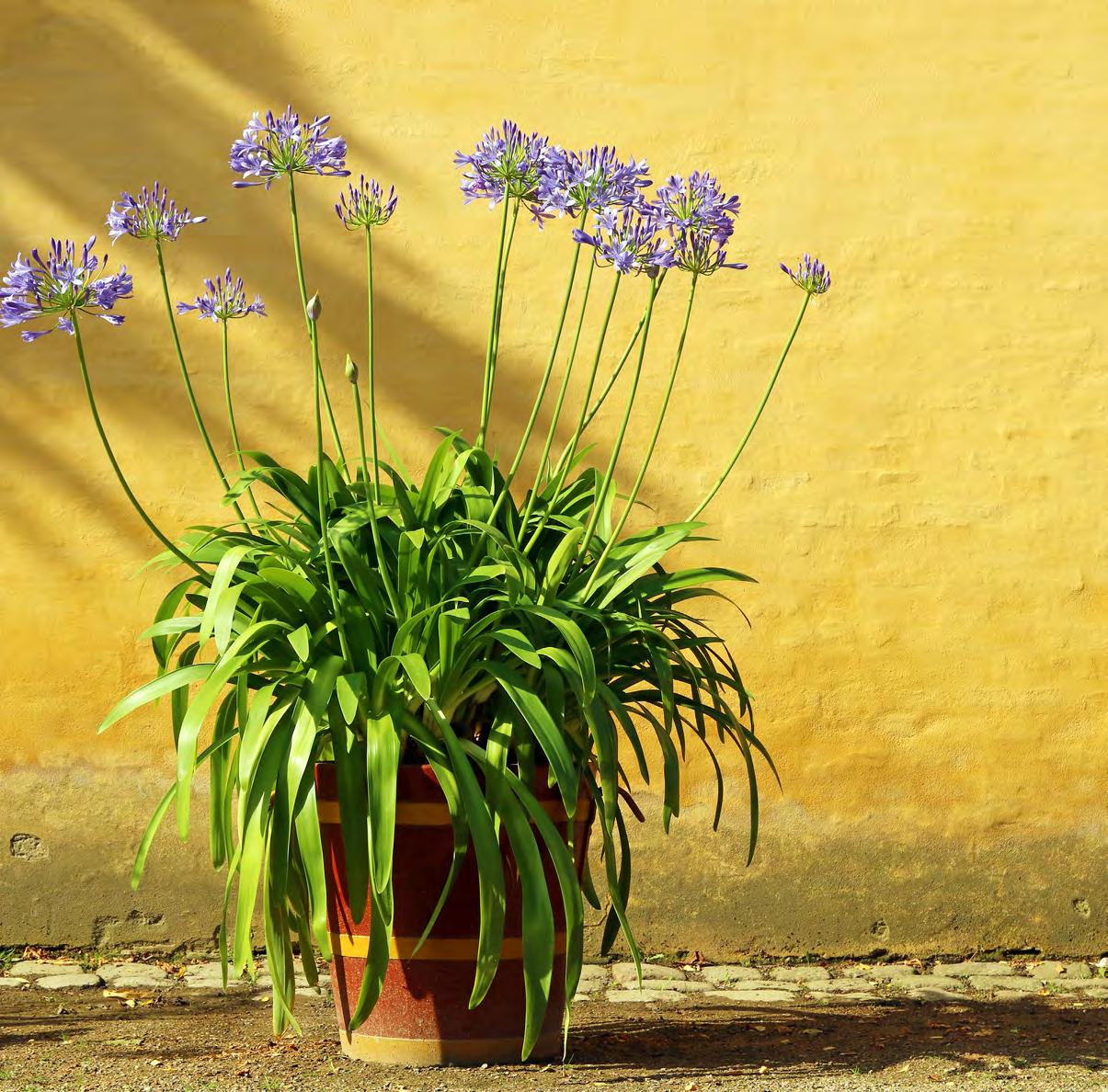
9 minute read
Let’s go outside
from SO Magazine May 2021
by One Media
SHOW YOURtrue colours
THIS SUMMER
Advertisement
SO’s resident gardening expert Victoria Truman suggests simple ideas on how you can create the most impact in your external space with the least effort…
It is truly amazing how mature trees and plants can completely transform virtually any outside space with immediate effect.
Many clients ask me how to bring instant impact into their garden. And I tell them that this is very achievable when you use sculptural topiary shapes. During the winter they look superb because of the drama they create, especially when frost and snow appears. Then in the summer months I find the topiary shapes add punctuation to the froth and colour of all those gorgeous summer flowers.
Trees are a fantastic way of bringing in interest vertically and the sky really is the limit with what size you buy! You’re basically buying time, the time it has taken to produce a large specimen tree is 7-15 years of a nursery man looking after the tree and caring for its every need so when it is planted in your garden you end up with not only an amazing, fully grown specimen, but one that has been nurtured and cared for.
If you’re after some instant colour then that can be can be added at very little cost with the use of colourful seasonal bedding plants. Plant them in pots and containers or use them to plug gaps in borders when other plants have died down.
To assure you have plenty of colour come early summer get ahead by thinking of the seasons. If Victoria Truman Garden Designer

you plant tulips en masse in November then by April/May you will have created a cacophony of colour within your space. By choosing larger specimens you will achieve instant and maximum impact with no wait time as the time of the plant maturing has already happened.
Now spring is truly underway, thoughts turn to summer and the garden. As you look at your garden, does the nagging question of "where do I even begin" sound familiar? In my opinion, the first and foremost thing to do is to stand back for a moment and simply enjoy the beauty that Mother Nature has given us... Listen to the birds as they sing you a spring melody... dream a little... put on the

gardening gloves and head out to make your dream garden a reality!
As you begin your quest for the perfect garden, be careful not to don't overdo it. It's probably been a few months since you gave those muscles and bones a good workout, so start out slowly and avoid that Monday morning backache. Going into May bulbs fade and herbaceous borders grow in leaps and bounds, it is now clear that summer is approaching.
Sowing and planting out bedding can begin, depending on regional weather variations, and you can take softwood cuttings. It's also time to get back into the lawn mowing regime, as the lawn will be loving the warmer temperatures this month brings.


SEW BEAUTIFUL
Some of my favourite plants to bring colour and impact are:
Hydrangea paniculata ‘Limelight’ which has dense clusters of long-lasting flowers that emerge in mid-summer lime green, fade to cream and finally turn shades of deep pink in autumn.
Euphorbia amygdaloides var. robbiae: A compact, shadeloving, spreading euphorbia that has long-lasting, lime-green flowers in late spring above rosettes of glossy, dark green leaves.
Bergenia ‘Abendglut’: Commonly known as elephant’s ears, because of their large, leathery, oval leaves, ‘Abendglut’ has vivid magenta flower spikes in spring and dark-green leaves, tinged with maroon, that turn bright maroon in winter. A favourite of Edwardian garden designer Gertrude Jekyll and plantswoman Beth Chatto, this sturdy plant should be planted in groups as ground cover, for edging borders or providing a foil for delicate foliage plants.
Agapanthus ‘Windsor Grey’: Decorative perennial which produces large heads of pale, grey-blue flowers from mid-tolate summer. It makes fine specimens in a pot, where their architectural silhouette can best be appreciated - or dot them through the summer border.
JOBS FOR MAY
1. Feed bare soil between plants with general-purpose fertiliser and dose acid-loving rhododendrons and camellias with sequestered iron. Blackberries, loganberries and blackcurrants need a highnitrogen feed
2. Prune the flowered shoots of hydrangeas and winter jasmine
3. Sow peas, broad beans, brassicas, leeks, root veg, spinach, chicory, Swiss chard, salad and hardy herbs. Start tender veg and half-hardy annuals – cosmos, nicotiana, snapdragons – under cover
4. Plant Jerusalem artichokes and asparagus crowns. Container-grown evergreens establish best in the spring. Fill pots with glamorous summerflowering bulbs
5. Pinch-out fuchsia, sweet peas and pelargoniums to encourage bushiness and heavier flowering
6. April is the month for planting summer flowering bulbs like Dahlias, Gladiolas and Lilies. Mix bulb fertilizer, processed manure and peat moss into the planting soil
7. When they have finished blooming, you should deadhead your spring flowering bulbs. Do not cut off the green foliage yet! These green leaves continue to grow for a few weeks and provide the bulb with food for flowering next year 8. Watch out for late frosts. Protect tender plants with muslin placed carefully over them until the warmer weather is here to stay
9. Earth up potatoes, and promptly plant any still remaining
10. Plant out summer bedding at the end of the month (except in cold areas) and always check for nesting birds before clipping hedges
11. Water early and late to get the most out of your water, recycle water when possible

Volkswagen WHAT’S THE SPEC LIKE? Sitting atop the Golf range means the R benefits from an impressive level of standard equipment. Prices start at just over £39,000, for which you get important performance aspects such as the torque vectoring system and sport suspension. ‘Our’ car came with optional Dynamic Chassis Golf R The new Golf R arrives riding a wave of expectation, but can it live up to it? Jack Evans finds out Control – priced at £300 – something we’d highly recommend. It allows you to vary the amount of support given by the suspension and when put in ‘Comfort’ mode, makes the car pliable enough to deal with the UK’s roads. Elsewhere, standard-fit highlights include Volkswagen’s digital cockpit with configurable dials, a 10-inch infotainment display with Apple CarPlay and Android Auto, and Matrix LED headlights. You’re unlikely to feel short-changed by the R’s level of standard equipment, that’s for sure.
VERDICT
Binging in a replacement for the Golf R must’ve seemed like quite the challenge for Volkswagen. However, it has hit the nail on the head again; this is a fearsomely quick car that is both easy to live with, and easy to get the best from too. It’s almost unnervingly easy to drive, in fact. It might not be the last word in driver involvement, but the older Golf R never was either. No, this is a car that provides all the performance you could want, no matter the weather.
WHAT IS IT?
The previous-generation Volkswagen Golf R earned itself a serious reputation. Its all-weather ability, supercar-beating performance and everyday practicality meant that, to many, it was all the car you could’ve ever needed or wanted – so how do you possibly replace it? That’s a challenge Volkswagen tackling with this new version.
Underpinned by the latest eightgeneration Golf platform, the new R has a crushing amount of expectation on its shoulders. Can it live up to the hype generated by the car it takes over from?
WHAT’S UNDER THE BONNET?
As highlighted, the new R uses a 2.0-litre turbocharged fourcylinder petrol engine, mirroring the capacity that was found in the previous car. It is fundamentally the same unit that powered the older R, albeit with some tweaks and revisions. It’s more powerful, too, bringing 316bhp and 420Nm of torque to the table, converted to the wheels via a seven-speed automatic gearbox.
It means the R is quicker from 0-60mph, too, now taking just 4.5 seconds to hit the speed, while flat-out it’ll do 155mph. However, as before, Volkswagen hasn’t lost sight of the R’s need to be used every day, which is why its economy figures aren’t too terrible; the firm claims 36.2mpg combined and CO2 emissions of 177g/km. right from the start – the Golf R is now quicker than anyone reasonably needs a car to be on the public road. Given that it’ll now out-pace many far more flamboyant – and expensive – cars, the level of performance the R delivers is nothing short of revolutionary. It’s backed by an all-wheel-drive system that keeps you on the straight and narrow – or clinging on through the bends – no matter the conditions.
The most notable addition to the R’s setup is the inclusion of torque vectoring, which allows power to be split between the rear wheels for the first time, rather than just the front and back axle. It means the car will tighten its line far more easily than before when turning in, and even applying a decent boot of throttle mid-corner causes the car to squat and pull around the bend harder than ever, firing you out of the other side. It’s properly impressive and wonderfully easy to exploit – this isn’t a car you need to ‘learn’ in order to get the best from.
WHAT’S IT LIKE INSIDE?
We’ve already experienced the regular Golf’s interior and found it to be an extremely tech-heavy place to be. The R’s cabin is little different, albeit with the introduction of more sporty seats and a range of blue accents. It does, however, feel a touch too ‘normal’ for a car like this; we’d like to see just a little more excitement added into the mix, given just how exciting the powertrain running underneath the R is.
That said, the everyday fundamentals are done well. The material quality is largely on the money, while there’s a decent amount of space for those sitting in the back, too. Boot space is reasonable too, offering up 374 litres with the rear seats in place. You can increase it by folding those seats down, of course. FACTS AT A GLANCE Model as tested: Volkswagen Golf R Base price: £39,270 Price: £42,300 Engine: 2.0-litre turbocharged petrol Power: 316bhp Torque: 420Nm Max speed: 155mph 0-60mph: 4.5 seconds MPG: 36.2 Emissions: 177g/km CO2

WHAT’S IT LIKE TO DRIVE?
It’s worth getting something out of the way










